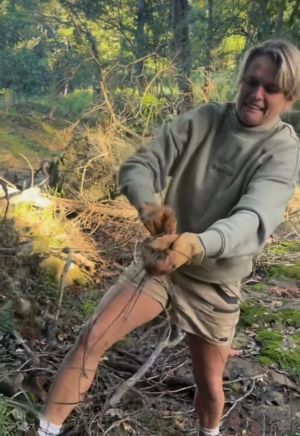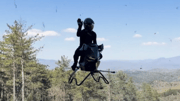Aussies embrace property trend that removes hidden danger from homes
By
Gian T
- Replies 0
Australia’s unique wildlife is one of our nation’s greatest treasures, but it’s also under constant threat—from habitat loss, invasive species, and, surprisingly, something as simple as old fencing.
Suppose you own a property, especially in rural or semi-rural areas.
In that case, you might be harbouring a hidden danger that is putting our native animals at risk without you even realising it.
For generations, barbed wire and other types of fencing have been a staple on Australian properties, used to keep livestock in and unwanted visitors out.
But as times change, so do the needs of the land. Many new property owners are buying up acreage not to run cattle or sheep but to enjoy a slice of the great outdoors, create a hobby farm, or simply have more space.
The problem? Old, unused fencing—especially barbed wire—often gets left behind, forgotten and overgrown.
Bridget, a resident of the Northern Rivers region in NSW and one-half of the conservation duo known as the ‘Wildlife Twins’, recently discovered just how dangerous these relics can be.
While clearing unused fencing from her grandfather’s 42-acre property, she found barbed wire hidden under debris and foliage, especially after recent floods.
'It’s a lovely piece of natural environment,' she said, 'but that barbed wire no longer serves a purpose and poses a definite hazard to wildlife.'
You might be wondering, 'What’s the harm in a bit of old wire?' The answer is heartbreaking. Every year, countless native animals—kangaroos, wallabies, bats, birds, and more—become entangled in barbed wire fences.
Many suffer severe injuries or die slow, painful deaths because they can’t free themselves.
Wildlife rescuers report responding to cases almost daily, with kangaroos being particularly vulnerable.
One Victorian wildlife rescuer shared a recent incident where a mother kangaroo, with her joey still in her pouch, was found dangling from a fence.
And it’s not just an isolated problem—Doug Gimesy, a new property owner in regional Victoria, found a kangaroo stuck in his fence the day after moving in.
The experience was so confronting that he spent 10 months removing 17 kilometres of hazardous wire from his property.
As more Aussies become aware of the issue, a quiet but powerful trend is emerging: ‘unfencing’.
This involves removing unnecessary or dangerous fencing, especially barbed wire, to create safer corridors for wildlife to move through.
It’s a simple act that can have a huge impact on local ecosystems, helping to regenerate land and support the survival of native species.
Bridget believes this movement is the future of conservation in Australia.
'I truly believe that’ll make a difference,' she said.
And she’s not alone—many conservationists and wildlife groups are encouraging property owners to inspect their land, especially after natural events like floods, and remove any fencing that’s no longer needed.
In a bid to balance the needs of farmers and wildlife, technology is stepping in.
The NSW government recently announced plans to legalise ‘virtual fencing’—a system where livestock wear GPS-enabled neckbands that emit sounds or mild electric shocks if they stray beyond set boundaries.
This means farmers can manage their herds without the need for physical fences, potentially reducing the risk to wildlife.
While virtual fencing is already in use in Queensland, Western Australia, Tasmania, and the Northern Territory, it’s not without controversy.
Animal welfare advocates have raised concerns about the stress it may cause livestock, especially if boundaries are frequently changed.
However, supporters argue it could be a game-changer for both agriculture and conservation, allowing for more flexible land use and safer habitats for native animals.
If you own or are considering buying a property—whether it’s a few acres or a sprawling farm—here are some steps you can take to help protect our wildlife:
Regularly inspect your land—especially after storms or floods—to check for hidden or overgrown fencing that could pose a hazard.
If you come across old barbed wire or dangerous materials, consider removing them, and reach out to local groups or contractors if the task is too large to handle alone.
Where fencing is still needed, choose wildlife-friendly designs that allow animals to pass through safely.
Getting involved with local conservation or landcare groups can provide valuable advice and support, and sharing your experiences with neighbours or online can help raise awareness and encourage others to take action.
It’s easy to overlook something as mundane as an old fence, but for our native wildlife, it can mean the difference between life and death.
By taking a little time to inspect and update your property, you can play a vital role in protecting Australia’s unique animals for generations to come.
 Have you discovered hidden dangers on your property? Have you joined the ‘unfencing’ movement or tried virtual fencing? We’d love to hear your stories, tips, and questions in the comments below.
Have you discovered hidden dangers on your property? Have you joined the ‘unfencing’ movement or tried virtual fencing? We’d love to hear your stories, tips, and questions in the comments below.
Suppose you own a property, especially in rural or semi-rural areas.
In that case, you might be harbouring a hidden danger that is putting our native animals at risk without you even realising it.
For generations, barbed wire and other types of fencing have been a staple on Australian properties, used to keep livestock in and unwanted visitors out.
But as times change, so do the needs of the land. Many new property owners are buying up acreage not to run cattle or sheep but to enjoy a slice of the great outdoors, create a hobby farm, or simply have more space.
The problem? Old, unused fencing—especially barbed wire—often gets left behind, forgotten and overgrown.
Bridget, a resident of the Northern Rivers region in NSW and one-half of the conservation duo known as the ‘Wildlife Twins’, recently discovered just how dangerous these relics can be.
While clearing unused fencing from her grandfather’s 42-acre property, she found barbed wire hidden under debris and foliage, especially after recent floods.
'It’s a lovely piece of natural environment,' she said, 'but that barbed wire no longer serves a purpose and poses a definite hazard to wildlife.'
You might be wondering, 'What’s the harm in a bit of old wire?' The answer is heartbreaking. Every year, countless native animals—kangaroos, wallabies, bats, birds, and more—become entangled in barbed wire fences.
Many suffer severe injuries or die slow, painful deaths because they can’t free themselves.
Wildlife rescuers report responding to cases almost daily, with kangaroos being particularly vulnerable.
One Victorian wildlife rescuer shared a recent incident where a mother kangaroo, with her joey still in her pouch, was found dangling from a fence.
And it’s not just an isolated problem—Doug Gimesy, a new property owner in regional Victoria, found a kangaroo stuck in his fence the day after moving in.
The experience was so confronting that he spent 10 months removing 17 kilometres of hazardous wire from his property.
This involves removing unnecessary or dangerous fencing, especially barbed wire, to create safer corridors for wildlife to move through.
It’s a simple act that can have a huge impact on local ecosystems, helping to regenerate land and support the survival of native species.
Bridget believes this movement is the future of conservation in Australia.
'I truly believe that’ll make a difference,' she said.
And she’s not alone—many conservationists and wildlife groups are encouraging property owners to inspect their land, especially after natural events like floods, and remove any fencing that’s no longer needed.
The NSW government recently announced plans to legalise ‘virtual fencing’—a system where livestock wear GPS-enabled neckbands that emit sounds or mild electric shocks if they stray beyond set boundaries.
This means farmers can manage their herds without the need for physical fences, potentially reducing the risk to wildlife.
While virtual fencing is already in use in Queensland, Western Australia, Tasmania, and the Northern Territory, it’s not without controversy.
Animal welfare advocates have raised concerns about the stress it may cause livestock, especially if boundaries are frequently changed.
However, supporters argue it could be a game-changer for both agriculture and conservation, allowing for more flexible land use and safer habitats for native animals.
Regularly inspect your land—especially after storms or floods—to check for hidden or overgrown fencing that could pose a hazard.
If you come across old barbed wire or dangerous materials, consider removing them, and reach out to local groups or contractors if the task is too large to handle alone.
Where fencing is still needed, choose wildlife-friendly designs that allow animals to pass through safely.
Getting involved with local conservation or landcare groups can provide valuable advice and support, and sharing your experiences with neighbours or online can help raise awareness and encourage others to take action.
It’s easy to overlook something as mundane as an old fence, but for our native wildlife, it can mean the difference between life and death.
By taking a little time to inspect and update your property, you can play a vital role in protecting Australia’s unique animals for generations to come.
Key Takeaways
- Removing old and unused barbed wire fencing on private properties is an important and growing trend to help protect native wildlife from injury and death.
- Many new landowners may be unaware of hidden or defunct fencing on their land, which can be hazardous to animals such as kangaroos, bats and birds.
- The NSW government is legalising virtual fencing, allowing farmers to use GPS technology and animal-worn collars instead of physical fences, aiming to benefit both farm management and native wildlife safety.
- While virtual fencing could reduce the need for hazardous physical fences, animal welfare experts caution that the new technology may cause anxiety or discomfort for livestock.








